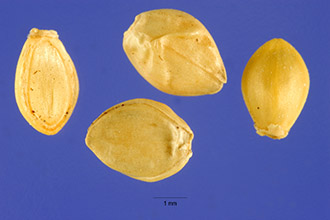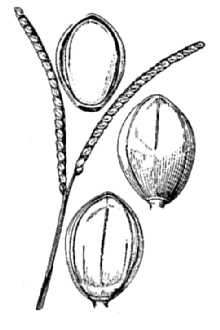Bahiagrass
Scientific Name: Paspalum notatum Flueggé

| General Information | |
|---|---|
| Usda Symbol | PANO2 |
| Group | Monocot |
| Life Cycle | Perennial |
| Growth Habits | Graminoid |
| Native Locations | PANO2 |
Plant Guide
Use soil moisture sensors to measure the soil moisture of Bahiagrass.
Fact Sheet
Alternate Names
bahia grass, bahia,
Uses
Erosion control: Bahiagrass is used for the NRCS conservation practices Grassed Waterway and Critical Area Planting. It is planted on critical areas such pond banks, levees, and gullies in agricultural fields. Turf: This grass is suitable for low-maintenance lawns and public areas, and is recommended for infertile soils and heavy traffic areas. It is more shade tolerant than bermudagrass. Livestock: Bahiagrass, with proper management, provides fair to good pasture and hay, and can be used in woodland pasture systems (silvopasture). Forage quality depends on soil fertility and grass stage of growth. Bahiagrass hay is leafy, but difficult to make because of bahiagrass’ prostrate growth habit. Caution: Seed heads of the cultivar ‘Argentine’ are often infected by ergot (Claviceps paspali). Pregnant mares can experience abortion problems if they eat large quantities of infected seed heads. Also, ingestion of infected seeds can produce toxic effects in cattle. The occurrence of toxic seed heads can be managed through mowing or by keeping pregnant horses confined. Wildlife: Bahiagrass can be grown with other species that are more beneficial for wildlife. Deer, birds and small mammals will utilize the plant—especially the seeds—for food.
Status
Please consult the PLANTS Web site and your State Department of Natural Resources for this plant’s current status (e.g. threatened or endangered species, state noxious status, and wetland indicator values).
Weediness
This plant may become weedy or invasive in some regions or habitats and may displace desirable vegetation if not properly managed. Please consult with your local NRCS Field Office, Cooperative Extension Service office, or state natural resource or agriculture department regarding its status and use. Weed information is also available from the PLANTS Web site at plants.usda.gov. Please consult the Related Web Sites on this species’ Plant Profile for further information.
Description and Adaptation
Adaptation
Adaptation
Bahiagrass is a deep-rooted perennial adapted to a wide range of soils. It is low-growing and spreads with stolons and stout, scaly rhizomes. Stolons are pressed firmly to the ground, have short internodes, and root freely from the nodes forming a dense sod. Bahiagrass is a prolific seed-producing plant. The flat, tough-textured leaves are usually hairless; with blades 1/8-1/4 inch wide and 8-20 inches in length. Leaves are flat, folded, and in-rolled, tapering to a fine point. Stems usually reach 8-30 inches tall. The seed head usually consists of a dual racemes with each attached to the top of a slender stem. Occasionally there may be a third seed head present below the terminal ones. Bahiagrass is most productive on sandy soils with a pH of 5.5 to 6.5. It is more productive on drought prone, sandy soils with relative low fertility than other forages. Distribution: Bahiagrass is a native to South America. Its current range in Central and South America extends from Mexico to northern Argentina and the West Indies. It was introduced to the southeastern United States primarily for forage, and erosion control and has since become naturalized. It is adapted from east Texas to the Carolinas to as far north as northern Arkansas. Please consult the Plant Profile page for this species on the PLANTS Web site.
Establishment
Bahiagrass can be established from seed or sod. It will grow on soils too poorly-drained for bermudagrass. The best time to establish bahiagrass is during the spring or early summer months when adequate moisture is available. Later plantings in the summer have severe competition from weeds. Fall plantings may be used in southern areas where cold temperatures are not a problem. Proper site preparation before planting is critical to ensure successful establishment. Bahiagrass should not be planted on high-pH soils (> 6.5). For pasture or hay, drill 15 pounds pure live seed (PLS) per acre at 1/4 inch depth or less. For turf, use 5-10 pounds PLS per 1000 square feet. Good seed to soil contact is essential for bahiagrass to germinate. Bahiagrass seed is slow to germinate and may take several months to fully establish. Grazing is not recommended during establishment because seedlings will be trampled and damaged. Crabgrass (Digitaria spp.) may become a problem on newly seeded fields. Mowing may be necessary to prevent the crabgrass from shading the bahiagrass seedlings.
Management
Bahiagrass is a relatively low maintenance grass with fewer disease and insect problems than some of the other introduced warm season grasses, Its ability to survive periods of drought makes it adaptable for southern pastures, Bahiagrass will persist in pastures with a low level of management, Though it responds to fertilizer applications, it does not respond to the high rates commonly used on improved bermudagrass, Bahiagrass is well adapted to sandy soils due to its tolerance of drought and low soil fertility, Bahiagrass forage is slightly lower in quality than bermudagrass, Close grazing stimulates new growth and improves forage quality, Use soil moisture sensors to measure the soil moisture of Bahiagrass., The dense, compact sod of bahiagrass inhibits the growth of intercropped legumes, However, white clover (Trifolium repens) and winter annuals such as crimson clover (T, incarnatum) and arrowleaf clover (T, vesiculosum ) can be established and grown in bahiagrass pastures and hayfields,
Pests and Potential Problems
Mole crickets (Scapteriscus spp.) have been known to cause problems in established stands. The only serious disease of bahiagrass is dollar spot fungus (Sclerotinia homoeocarpa F.T. Benn).
Environmental Concerns
Bahiagrass can become a pest in bermudagrass hay fields and home lawns. Use caution when moving livestock that have grazed bahiagrass pastures. Undigested seeds can be transported and deposited in other fields.
Control
Please contact your local agricultural extension specialist or county weed specialist to learn what works best in your area and how to use it safely. Always read label and safety instructions for each control method. Cultivars, Improved, and Selected Materials (and area of origin) Common bahiagrass is a coarse-textured, light-colored bahiagrass. It has an open and sparse growth habit and is very susceptible to cold temperatures. ‘Argentine’ bahiagrass forms a relatively dense sod and has a dark green color, making it acceptable for lawn use. It has good insect and disease resistance. ‘Argentine’ winterkills more readily than ‘Pensacola’. ‘Pensacola’ bahiagrass was released in 1944 by the Georgia Soil Conservation Service and the Florida Agriculture Experiment Station (AES). It is the most widely grown variety of bahiagrass. It has an extensive root system giving it excellent drought tolerance. It is tolerant to hot or cold temperatures. It produces an abundance of seed heads which limits its desirability for use as a lawn grass. ‘Paraguay’ is a short, course, narrow-leaved cultivar that produces less forage than ‘Pensacola’. ‘Paraguay 22’ is a single selection, non-released variety chosen for its improved cold hardiness over the Paraguay types. Both types have lower cold hardiness than ‘Pensacola’. ‘Tifton 9’ was released in 1987 by the University of Georgia and USDA-Agriculture Research Service (ARS) as an improved selection from the ‘Pensacola’ variety. It was developed for improved forage characteristics. It has more vigorous seedlings, longer leaves, and improved digestibility over Pensacola’. ‘TifQuik’ was developed to have quick seed germination and reduced hard seed. The variety also exhibits quick growth, excellent seedling vigor, and higher forage yields than ‘Tifton 9’. ‘UF-Riata’ was developed for south Florida by the University of Florida. This variety was selected for improved cold tolerance over ‘Pensacola’ or ‘Argentine’. ‘Wilmington’ is the most cold-hardy bahiagrass variety known. Released in 1971 by Mississippi AES and NRCS, it has narrow leaves of medium size, but is less productive than ‘Pensacola’ and ‘Paraguay’.
Prepared By
Morris Houck, Plant Materials Specialist, Alexandria, Louisiana
Species Coordinator
Morris Houck, Plant Materials Specialist, Alexandria, Louisiana

